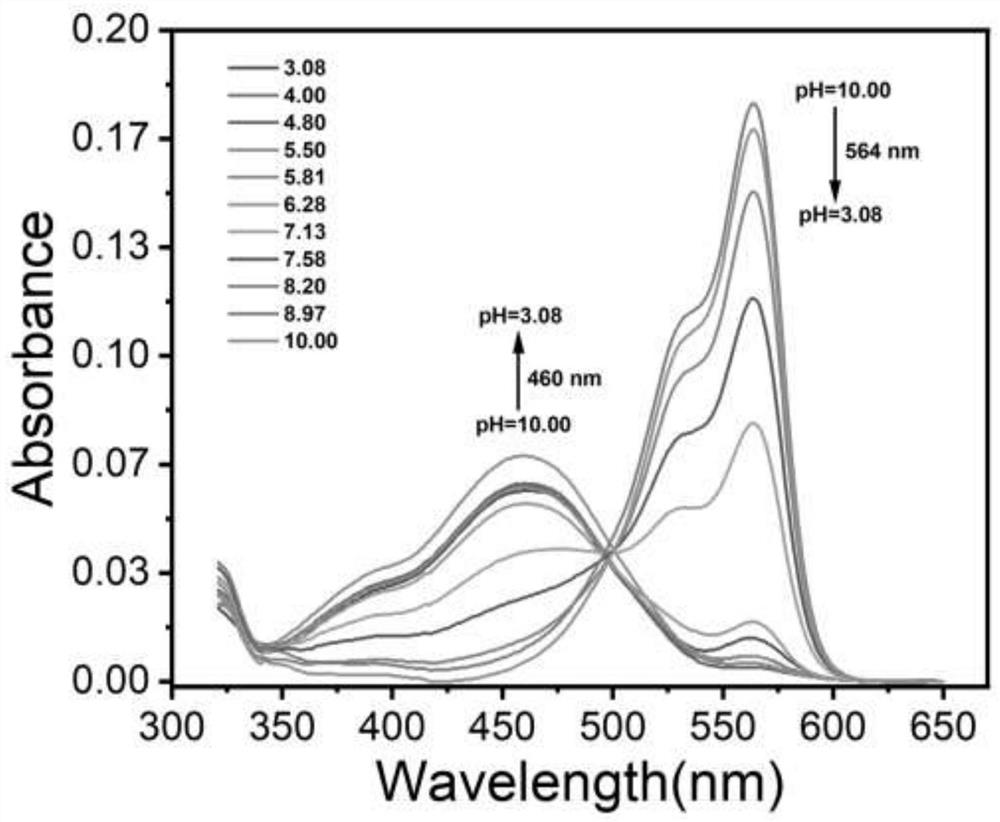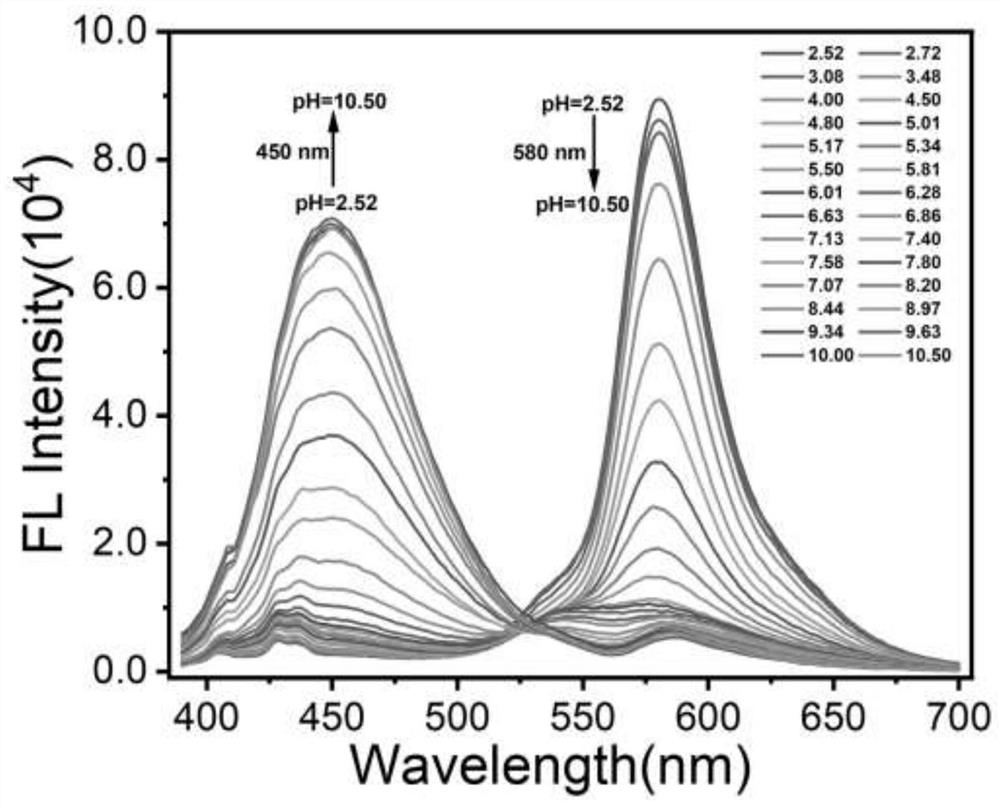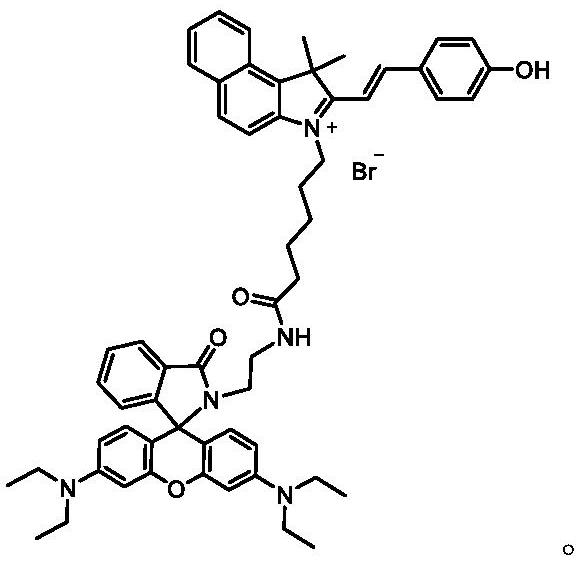A kind of pH-sensitive ratio type semicyanine-rhodamine dye and preparation method thereof
A semi-cyanine, ratio-type technology, applied in the direction of organic dyes, styrene-based dyes, chemical instruments and methods, etc., can solve the problems of inaccuracy, low quantum yield, insensitive detection of fluorescent dyes, etc., and achieve high yield , the synthesis method is simple, the effect of good application prospect
- Summary
- Abstract
- Description
- Claims
- Application Information
AI Technical Summary
Problems solved by technology
Method used
Image
Examples
Embodiment 1
[0029] Example 1 Synthesis of pH sensitive ratio dyes
[0030] (1) Weigh 2.0 g of 1,1,2-trimethylbenzo[e]indole into a 100 ml flask, and add 30 ml of dry acetonitrile. After being dissolved, 3.73 g of 6-bromohexanoic acid was added, and the mixture was reacted at 80° C. under reflux for 36 hours. After the reaction was completed, it was cooled to room temperature, and most of the acetonitrile was removed under reduced pressure distillation. The product was dropped into anhydrous ether, and a gray-blue solid was precipitated. After suction filtration, the filter cake was washed three times with anhydrous ether to obtain the pure product 3-(5-carboxypentyl)-1,1,2-trimethyl-1H-benzo[e]indole (compound 1), Yield 88%.
[0031] (2) Weigh 1 g of 3-(5-carboxypentyl)-1,1,2-trimethyl-1H-benzo[e]indole in step (1) and dissolve it in 30 ml of absolute ethanol, After dissolving, add 0.41 g of p-hydroxybenzaldehyde, then add 2-3 drops of piperidine dropwise, and heat to reflux for 18 hou...
Embodiment 2
[0035] Embodiment 2 configures the Britton-Robinson-Ethanol (BRE) buffer solution of different pH values
[0036] (1) Weigh 1.96 grams of phosphoric acid, 1.2 grams of acetic acid, and 1.24 grams of boric acid and dissolve them in 250 milliliters of double-distilled water and 250 milliliters of ethanol to obtain a mixed solution of the three acids.
[0037] (2) After the pH three composite electrodes are calibrated, adjust the three-acid mixed solution prepared in step (1) with 1.0M NaOH solution or 1.0M HCl solution to obtain BRE buffer solutions with different pH values.
Embodiment 3
[0038] Example 3 Test the UV absorption and fluorescence emission spectra of the dye molecules in the BRE buffer at different pH values
[0039] (1) Configure a 1.0mM dye stock solution, add 10 microliters of the stock solution to the quartz cuvette, use BRE buffers of different pH to make the dye concentration 20µM, and then use a UV-visible spectrophotometer to test 320- UV absorption spectrum under different pH conditions in the range of 650nm, such as figure 1 shown.
[0040] (2) After adding 10 microliters of the stock solution of the dye prepared in step (1) to the quartz cuvette, the concentration of the dye is 20 μM after constant volume with BRE buffer solution of different pH, and then tested with a fluorescence spectrometer at 390 Fluorescence emission spectra under different pH conditions in the range of -700nm, the excitation wavelength of the fluorescence spectrum is 380nm, and the emission wavelengths are 450nm and 580nm, such as figure 2 shown.
PUM
 Login to View More
Login to View More Abstract
Description
Claims
Application Information
 Login to View More
Login to View More - R&D
- Intellectual Property
- Life Sciences
- Materials
- Tech Scout
- Unparalleled Data Quality
- Higher Quality Content
- 60% Fewer Hallucinations
Browse by: Latest US Patents, China's latest patents, Technical Efficacy Thesaurus, Application Domain, Technology Topic, Popular Technical Reports.
© 2025 PatSnap. All rights reserved.Legal|Privacy policy|Modern Slavery Act Transparency Statement|Sitemap|About US| Contact US: help@patsnap.com



